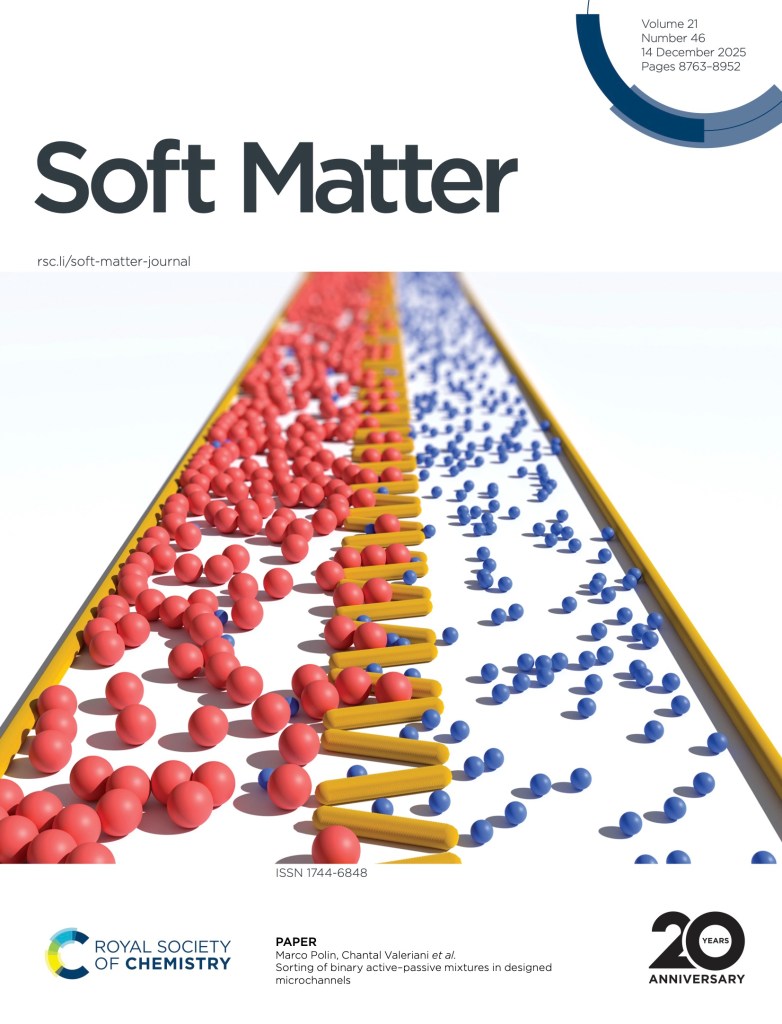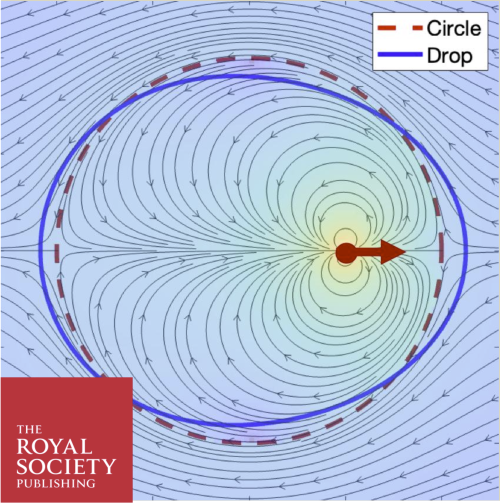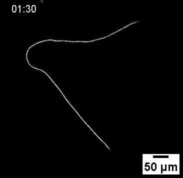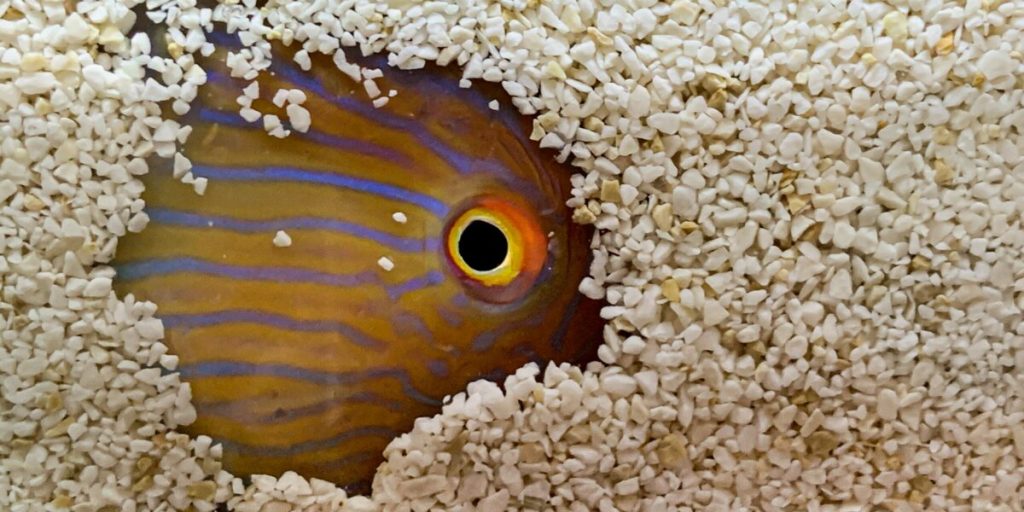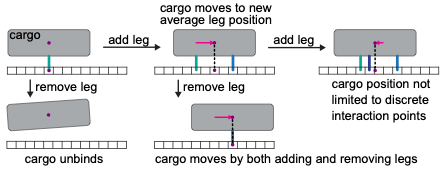An active-passive system is composed of an ensemble of active out-of equilibrium agents, interacting with passive ones. This could be the interior of a cell, with molecular motors creating flows which transport passive (as in: non-active) material; or it could be non-motile bacteria buffeted around by motile ones (see also bacterial hitchhiking!). In all of these cases, the active “bath” changes significantly the stochastic properties of the passive components. Together with Horacio Serna, Miguel Barriuso, Ignacio Pagonabarraga and Chantal Valeriani, we studied one example of these properties, where activity leads to an enhanced sorting of the system. The paper is out now on Soft Matter and we also got one of the two issue covers!
Separating cilia with a oh-so-thin blade
Multiple beating cilia need some form of coupling to synchronise. In groups of cells, hydrodynamic coupling can be enough… but for single cells, it seems to be essential to have internal mechanical connections. In this case, does hydrodynamics play any role at all? In a new paper, just out in Physical Review Letters (Editors’ Suggestion!), we use a tip-less AFM cantilever (sub-micron thin!) to block hydrodynamic coupling between the two flagella of a single Chlamydomonas cell. The results highlight a striking difference between wild type, with its two different flagella, and the flagellar dominance mutant ptx1. This work was spearheaded by Luc Zorrilla (who’s just defended his thesis!), in collaboration with Antoine Allard (LOMA, U. Bordeaux) and Krish Desai (former MPhys student, Physics Department, U. Warwick).
Congratulations Dr. Zorrilla!
We are very happy to announce that on Friday Sept 26th, Luc has successfully defended hi Ph.D. thesis and is henceforth known as Dr. Zorrilla 🙂 The thesis panel, with Helene de Maleprade, Vasily Kantsler and Jorge Arrieta, recognised his great work by awarding him a cum laude. Congratulations Luc!
Biological fluid dynamics:emerging directions
We are happy to announce the publication of a special issue “Biological fluid dynamics: emerging directions” in Philosophical Transactions of the Royal Society A. The special issue, which presents contributions at the cutting edge of research biological fluid dynamics, crowns the epilogue of the (first?) Biological Fluid Dynamics Special Interest Group of the UK Fluids Network. It was co-edited by Marco, together with Dave Smith (U. Birmingham, UK), Smitha Maretvadakethope (Imperial College London, UK) and Laurence Wilson (U. York, UK). It has been an absolute privilege to work with Dave, Smitha and Laurence on this, and we were excellently supported by the editorial staff of Royal Society Publishing. I hope the issue will be of interest not only to the biofluids community but also to the many other scientific communities that intersect this vibrant interdisciplinary area. I wish you all a good read!
Reversals and plectonemes in gliding cyanos
Cyanobacteria are ubiquitous photosynthetic microorganisms producing oxygen for approximately every fifth breath we take. Many live in filaments that can reach hundreds of cells and these filaments can coordinate to glide and even reverse direction. Direction reversal requires a sufficient number of cells to coordinate and start pushing in the opposite direction, a mechanism that is not well understood. In a new study just published on eLife we look into these coordinated reversals (experiments and modelling) and show that failure to coordinate leads to the formation of plectonemes (well known to whoever has had a tangled telephone cable…). This work was the result of a collaboration with the groups of our friends Orkun Soyer (who lead the study; U. Warwick), Chantal Valeriani (U. Complutense) and Emanuele Locatelli (U. Padova).
Hands-On School at ICTP

It was a real pleasure to be part of the Hands-On School in Complex Systems organised at ICTP (Trieste, Italy) over the first two weeks of December 2024. In the best tradition of ICTP, the school was geared towards young scientists from developing countries. Together with Sujeet we contributed activities on microbial tracking and phototaxis and did our best with students mentoring. …we also learned quite a lot of new things from the other participants! A big thanks to the organisers and to ICTP for hosting us.
Synchronised growth oscillations in fungi
We had the pleasure to collaborate with the groups of Munehiro Asally and Orkun Soyer on investigating the long-term growth dynamics of hyphae of S. indica, a root-colonising fungus (…sounds scary but it’s good). We were all surprised when it turned out that the growth of the different hyphae synchronises in system-wide oscillations lasting many hours. Want to know more? The paper, led by Praneet Prakash, has just been published by the Journal of the Royal Society Interface. You can read it here!
Visit by Orkun Soyer
This September we’re delighted to be hosting Orkun Soyer, Professor at the School of Life Sciences of the University of Warwick, collaborating on a project which aims to sample wild species of freshwater cyanobacteria in Mallorca (…yes, there are fresh water bodies in Mallorca!). His stay is financed through a Visiting Fellowship from the University of the Balearic Islands (kudos!). Looking forward to what will come out of this!
Predicting seasonal spawning of fish
We had fun helping our friends from MARES at IMEDEA on their quest to better understand the dynamics of fish spawning. The data available are sea surface temperature, fishery-dependent sampling and the gonadosomatic index of the captured fish. The result, published in Marine Environmental Research, is an experimentally validated model that allows one to predict the timing of spawning peak in a population of wild fish and its dependence on temperature variations. It’s cool to think that this could help improve the management of fisheries and make it more sustainable. Thanks to our friends Vincenç, Miquel, Andrés and Ignacio for involving us in the project!
Tracking with multiple legs
How do you move on a substrate if you have many “legs”? Together with Lewis Mosby and Anne Straube we have explored this problem in a paper just accepted on the Journal of Royal Society Interface (link; a version of this work is also available on the arXiv). Turns out that the spatial variation of binding rates can make you surf fast enough to follow the polymerisation of the substrate… all captured analytically!
